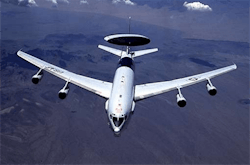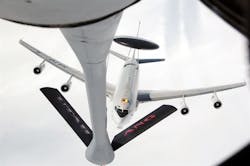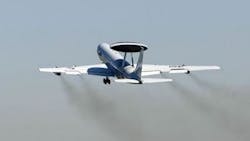The E-3 Sentry is an Related reading: L-3 upgrades AWACS DRAGON flight crew training system with Quantum3D visuals" target="_blank">airborne warning and control system (Related reading: L-3 upgrades AWACS DRAGON flight crew training system with Quantum3D visuals" target="_blank">AWACS), aircraft with an integrated command and control battle management (C2BM), surveillance, target detection, and tracking platform. The aircraft provides an accurate, real-time picture of the battlespace to the Joint Air Operations Center. AWACS provides situational awareness of friendly, neutral and hostile activity, command and control of an area of responsibility, battle management of theater forces, all-altitude and all-weather surveillance of the battle space, and early warning of enemy actions during joint, allied, and coalition operations.
The E-3 Sentry is a modified Boeing 707/320 commercial aircraft airframe with a rotating radar dome. The dome is 30 feet (9.1 meters) in diameter, six feet (1.8 meters) thick, and is held 11 feet (3.33 meters) above the fuselage by two struts. It contains a radar subsystem that permits surveillance from the Earth's surface up into the stratosphere, over land or water. The radar has a range of more than 250 miles (375.5 kilometers). The radar combined with an identification friend or foe (IFF), subsystem can look down to detect, identify and track enemy and friendly low-flying aircraft by eliminating ground clutter returns that confuse other radar systems.
Related reading: L-3 upgrades AWACS DRAGON flight crew training system with Quantum3D visuals
Major subsystems in the E-3 are avionics, navigation, communications, sensors (radar and passive detection), and identification tools (IFF/SIF). The mission suite includes consoles that display computer-processed data in graphic and tabular format on video screens. Mission crew members perform surveillance, identification, weapons control, battle management, and communications functions.
The radar and computer subsystems on the E-3 Sentry can gather and present broad and detailed battlefield information. This includes position and tracking information on enemy aircraft and ships, and location and status of friendly aircraft and naval vessels. The information can be sent to major command and control centers in rear areas or aboard ships. In time of crisis, this data can also be forwarded to the president and secretary of defense.
In support of air-to-ground operations, the Sentry can provide direct information needed for interdiction, reconnaissance, airlift and close-air support for friendly ground forces. It can also provide information for commanders of air operations to gain and maintain control of the air battle.
As an air defense system, E-3s can detect, identify and track airborne enemy forces far from the boundaries of the United States or NATO countries. It can direct fighter-interceptor aircraft to these enemy targets. Experience has proven that the E-3 Sentry can respond quickly and effectively to a crisis and support worldwide military deployment operations.
AWACS may be employed alone or horizontally integrated in combination with other C2BM and intelligence, surveillance, and reconnaissance elements of the Theater Air Control System. It supports decentralized execution of the air tasking order/air combat order. The system provides the ability to find, fix, track, and target airborne or maritime threats and to detect, locate and ID emitters. It has the ability to detect threats and control assets below and beyond the coverage of ground-based command and control or C2, and can exchange data with other C2 systems and shooters via datalinks.
With its mobility as an airborne warning and control system, the Sentry has a greater chance of surviving in warfare than a fixed, ground-based radar system. Among other things, the Sentry's flight path can quickly be changed according to mission and survival requirements. The E-3 can fly a mission profile approximately 8 hours without refueling. Its range and on-station time can be increased through in-flight refueling and the use of an on-board crew rest area.
Engineering, test, and evaluation began on the first E-3 Sentry in October 1975. In March 1977 the 552nd Airborne Warning and Control Wing (now 552nd Air Control Wing, Tinker Air Force Base, Okla.), received the first E-3s.
There are 31 aircraft in the U.S. inventory. Air Combat Command has 27 E-3s at Tinker. Pacific Air Forces has four E-3 Sentries at Kadena AB, Japan and Elmendorf AFB, Alaska.
NATO has 17 E-3A's and support equipment. The first E-3 was delivered to NATO in January 1982. The United Kingdom has seven E-3s, France has four, and Saudi Arabia has five. Japan has four AWACS built on the Boeing 767 airframe.
The E-3 has also deployed to support humanitarian relief operations in the U.S. following Hurricanes Rita and Katrina, coordinating rescue efforts between military and civilian authorities.
The data collection capability of the E-3 radar and computer subsystems allowed an entire air war to be recorded for the first time in the history of aerial warfare.
In March 1996, the Air Force activated the 513th Air Control Group, an AWACS Reserve Associate Program unit which performs duties on active-duty aircraft.
During the spring of 1999, the first AWACS aircraft went through the Radar System Improvement Program. RSIP is a joint U.S./NATO development program that involved a major hardware and software intensive modification to the existing radar system. Installation of RSIP enhanced the operational capability of the E-3 radar electronic counter-measures and has improved the system's reliability, maintainability and availability.
The AWACS modernization program, Block 40/45, is currently underway. Bock 40/45 represents a revolutionary change for AWACS and worldwide Joint Command and Control, Battle Management, and Wide Area Surveillance. It is the most significant counter-air battle management improvement in Combat Air Forces tactical Command and Control history. The Block 40/45 Mission Computer and Display upgrade replaces current 1970 vintage mission computing and displays with a true open system and commercial off-the-shelf hardware and software, giving AWACS crews the modern computing tools needed to perform, and vastly improve mission capability. Estimated fleet upgrades completion in 2020.
General characteristics
Primary function: airborne battle management, command and control
Contractor: Boeing Aerospace Co.
Power plant: four Pratt and Whitney TF33-PW-100A turbofan engines
Thrust: 20,500 pounds each engine at sea level
Rotodome: 30 feet in diameter (9.1 meters), 6 feet thick (1.8 meters), mounted 11 feet (3.33 meters) above fuselage
Wingspan: 145 feet, 9 inches (44.4 meters)
Length: 152 feet, 11 inches (46.6 meters)
Height: 41 feet, 9 inches (13 meters)
Weight: 205,000 pounds (zero fuel) (92,986 kilograms) Maximum Takeoff Weight: 325,000 pounds (147,418 kilograms) Fuel Capacity: 21,000 gallons (79,494 liters)
Speed: optimum cruise 360 mph (Mach 0.48)
Range: more than 5,000 nautical miles (9,250 kilometers)
Ceiling: Above 29,000 feet (8,788 meters)
Crew: flight crew of four plus mission crew of 13-19 specialists (mission crew size varies according to mission) Unit Cost: $270 million (fiscal 98 constant dollars) Initial operating capability: April 1978
Inventory: active force, 32 (one test); Reserve, 0; Guard, 0
Information and images courtesy of the U.S. Air Force.



